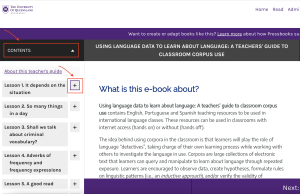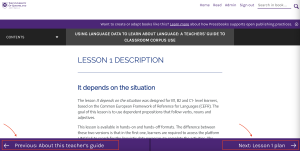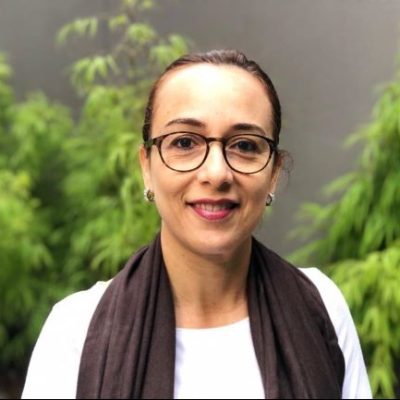About this teacher’s guide
Paula Tavares Pinto and Franciele Spinelli
What is this e-book about?
Using language data to learn about language: A teachers’ guide to classroom corpus use contains English, Portuguese and Spanish teaching resources to be used in international language classes. These resources can be used in classrooms with internet access (hands on) or without (hands off).
The idea behind using corpora in the classroom is that learners will play the role of language “detectives”, taking charge of their own learning process while working with others to investigate the language in use. Corpora are large collections of electronic text that learners can query and manipulate to learn about language through repeated exposure. Learners are encouraged to observe data, create hypotheses, formulate rules on linguistic patterns (i.e., an inductive approach), and/or verify the validity of grammatical rules from textbooks (i.e., a deductive approach). This perspective is called Data-Driven Learning (DDL), and is now widely featured in Computer Aided Language Learning (CALL) research (Boulton, 2010; Crosthwaite, 2020; Frankenberg-Garcia, 2021; Pérez-Paredes, 2020; Scott, 2010; among others).
How to navigate this e-book?
To navigate the lessons of this e-book, you can:
1. Once you have chosen the lesson you would like to access, click on the lesson hyperlinks in the descriptions below.
2. Click on the CONTENTS tab on the top-left corner of your Pressbook (located underneath the University of Queensland logo). Once you have chosen the lesson you would like to access, you can click on the + button to select the lesson section (see screenshot below).

3. Click on the Next button on the bottom-right corner to move to the next section of the following lesson. You can return to the previous page or lesson section by clicking on the Previous button on the bottom-left corner (see screenshot below).

Ready-made DDL lesson plans for in-class use
This collection of ready-made DDL lesson plans is curated to help both new and experienced teachers introduce DDL concepts into their language lesson planning.
In each lesson listed below, teachers and learners will find a description of the target tool and a link to a short video, in which the author(s) of the lesson explain(s) how this tool can be used. Detailed lesson plans are included, which can be used as a starting point or as an inspiration for the creation of future class activities.
Most of the lesson activities can be done 1) with access to the internet (hands on); and/or 2) without access to the internet (hands off). This is useful for schools where students are not allowed to use their own devices, or where internet access is not available.
Lesson 1: It depends on the situation
Designed by William Garcia, the lesson focuses on how to use Linggle to teach dependent prepositions to intermediate and advanced-level English learners.
Lesson 2: So many things in a day
Targeting High School students, William Garcia introduces learners to SKELL for the search of colloquial expressions in English with verbs be, have, get, put and take.
Lesson 3: Shall we talk about criminal vocabulary
In this lesson, Ariane Caldas and Adriane Orenha Ottaiano suggest vocabulary activities for teaching English to High School learners through the use of criminal TV series. Learners will use COCA (Corpus of Contemporary American English) as a research source.
Lesson 4: Adverbs of frequency and frequency expressions
Designed by Jeane Costa, the lesson focuses on adverbs and expressions of frequency. SKELL will be used, which allows the search of several examples of different grammatical and lexical combinations of the same word.
Lesson 5: A good read
Elaborated by Liliane Lopes, the lesson focuses on university-level English learners, who will write a book report (book summary) using adjectives and descriptive expressions. COCA will be used as a research source.
Lesson 6: Surfing the internet and other computer collocations
The lesson was developed by Luciano da Silva and aims to teach the use of collocations and vocabulary on computer science in English to students of technical and technological education. Students will access SKELL as a research source for this activity.
Lesson 7: Let’s talk about Brazilian culture
In this lesson, Talita Serpa proposes the teaching of Brazilian culture vocabulary to High School and/or translation course students through the use of Linguee, DeepL tools or Google Translator, and COCA.
Lesson 8: What a queer thing to say!
In this lesson, Talita Serpa introduces the use of different translation tools and electronic corpora for the discussion of idiomatic expressions and taboo lexicon from authentic contexts of use.
Lesson 9: Is this love?
In this lesson, Carolina de Carvalho presents activities to beginner and intermediate-level English learners, who will search for the word ‘love’ in different authentic contexts of use in the open access tools Corpora Lancs and Versatile.
Lesson 10: Seal the deal
Designed by Talita Serpa and Celso Rocha, this lesson introduces legal expressions on sale and purchase contracts to Language and Translation course students. For this lesson, learners will accessTradCorpus, in which bilingual digital glossaries and numerous online tools can be found.
Lesson 11: Does it collocate?
In this lesson, Paula Pinto suggests teaching academic collocations to postgraduate students for their academic abstract writing with the support of Collocaid.
Lesson 12: Many languages, many cultures
In this lesson, Paula Pinto suggests the use of Compara corpus of literary translations, in which High School learners will have access to translated novels from Portuguese into English and vice versa. Learners will have the opportunity to learn and discuss culturally-marked terms about indigenous tribes.
Lesson 13: Poetry translation
Aline Yuri Kiminami and Aline Cantarotti introduce this lesson for language teaching in translator training courses through the translation of poetry and the use of translation memory tools, such as Wordfast Anywhere, digital dictionaries and open access corpora.
Lesson 14: An unforgettable event
Lessons 14 and 15 focus on Spanish as a second language and were designed by Silmara Moscatelli. In Lesson 14 , the author proposes the teaching of protocols vocabulary for organising events during the pandemic with the help of electronic corpora, word lists, and concordance lines from Sketch Engine.
Lesson: 15 ¡Cuándo me falte fuerza, resistiré!
Lesson 15 focuses on temporal expressions through the use of Voyant Tools.
We hope that this Teachers’ Guide will serve as an inspiration for teachers and students of English and Spanish as a second language for the improvement of their bilingual lexicon, and as an invitation to future explorations of linguistic patterns in both languages!
February, 2023



